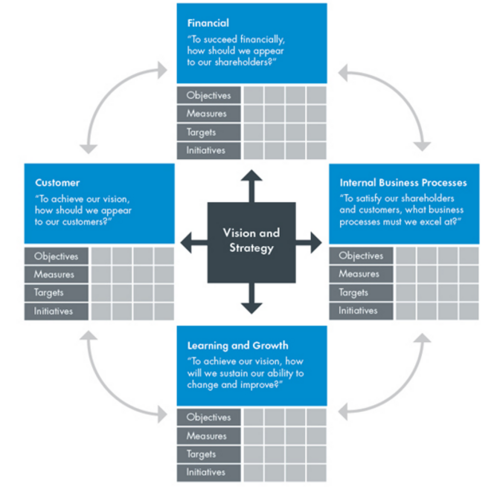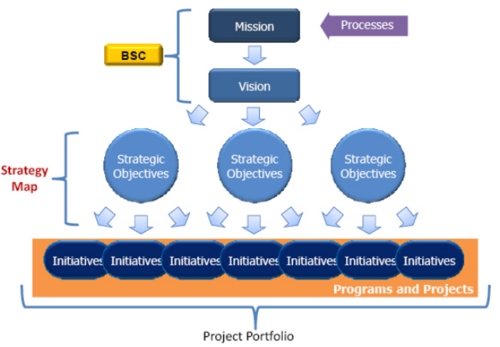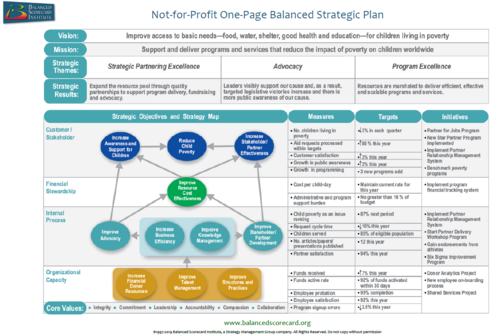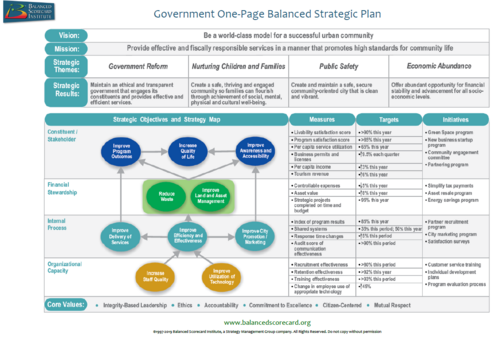The Balanced Scorecard (BSC)
Contents |
Abstract
The Balanced Scorecard approach
The Balanced Scorecard is a strategic planning and management system. Managers and organizations use the balanced scorecard to communicate what they are trying to accomplish, align the day-to-day work that everyone is doing with strategy, prioritizing projects, product and services, and measure and monitor progress towards strategic targets. The thought behind the Balanced Scorecard comes from the idea of looking at strategic measures in addition to traditional financial measures to get a more balanced view of performance [1]. Today, the tool has evolved into a comprehensive system for managing strategy, extending beyond the use of different perspectives. By adopting a disciplined framework, Managers can establish clear connections between the components of strategic planning and management. This helps to ensure that there is a visible connection between the projects and programs being undertaken and chosen, the measurement being used to track success (KIPs), the strategic objectives the organization is trying to accomplish, and the vision, mission, and strategy of the organization. The Balanced Scorecard approach examines an organization vision and translate it into performance measurements (KPIs) viewed from four different perspective: Financial, customer, internal processes, learning and growth [2].
The four perspectives
The financial perspective: Focus on the financial objectives of the organization and help managers track financial success. Cash flow, return of investment, and shareholder value are examples of variables which can be used in this perspective. The attention is on how the organization should appear from a stakeholder holder standpoint.
Customer perspective: Focus on the customer side and help managers look at customer objectives. Customer satisfaction surveys, customer retention rates, and market share are examples of variables which can be used in this perspective. The attention is on how the organization should appear from a customer perspective.
Internal processes perspective: Focus the attention on the key operational goals and the processes needed to satisfy the shareholders and deliver the customer objectives. The inventory, quality control, and product lead time are examples of variables that can be used in this perspective.
Learning and growth perspective: Focus on the intangible drivers of future success with attention to people, systems, and organizational procedures. Training, leadership, database, skills, and organizational culture are examples of variables which can be used in this perspective.
These four perspectives of the scorecard permit a balance between short and long-term objectives, between outcomes desired and the performance drivers of those outcomes, and between hard objectives measure and softer, more subjective measures. Every perspective also has four key performance measurements [3].
The performance measurements (KPI)
Objectives: Are short- and long-term tangible strategic objectives derived from an organization’s vision and strategy. For example, an on-time delivery objective on the business unit scorecard can be translated into an objective to reduce setup times at a specific machine, or to a local goal for rapid transfer of orders from one process to the next.
Measures: When formulating customer objectives, it will become clear that each executive had a different definition as to what, for example “superior service to targeted customers” represents and who were the targeted customers. The process of developing operational measures for the scorecard brings consensus among the executives. The measures are financial and nonfinancial and are balanced between the “outcome measures (lag indicators)” the final result from past efforts: Return on equity, customer retention, new product revenue and so on, and the “performance drivers (lead indicators)” that drive future performance: satisfaction survey, production development cycle, revenue mix and so on.
Targets: Targets refer to the scorecard measures that, if achieved, will transform the company. The target should represent a discontinuity in business unit performance. For example, doubling the return on invested capital, or a 150% increase in sales during the next five years.
Initiatives: Initiatives are the actions (projects) an organization puts in place in the attempt to transform themselves to compete successfully in the future, these initiatives must be aligned with what stated in the BSC [4].

Connection between Project Portfolio management and the Balanced Scorecard
The Role of the Portfolio Management (PPM)
Unlike a project, which has defined end goals and deliverables, a portfolio represent a more strategic planning commitment to continuously optimizing the allocation, prioritization and scheduling of resources across many projects. The role of the Project portfolio manager is to oversee the management of the project’s portfolio. This includes approving and rejecting projects and program ideas. The key responsibility of the PPM is getting a return on investment and meeting the goals and objectives of their organization [6].
Strategic planning
Strategic planning is the process where an organization’s mission, vision and the approach to achieve them are established by the upper management. The process continues with the establishment of the goals and strategic objectives, which are the intended achievements of the organization in terms of business result, based on the financial, customer, instructors, products, services, or cultural outcomes. The goals provide the measure by which the objectives are reached or not. This information is then set into a strategic document called a “Strategic plan.” [7].
The role of BSC
From a project portfolio management standpoint, the Balanced Scorecard serves as a valuable tool for documenting the strategic initiatives that are essential to achieve the organization’s mission and vision. This helps the project portfolio manager in prioritizing which project and program ideas to follow and which to reject. By utilizing the BSC, project portfolio managers can analyze, evaluate, prioritize, plan, and potentially execute projects and programs that will transform the organization’s mission and vision into concrete results. In the figure below, we can see the process of how to achieve a strategic leap. The organization’s mission and vision are influenced by various sources, including processes, which offer guidance in identifying the strategic initiatives that are most likely to achieve these goals. These initiatives are then transformed into specific projects and programs, typically organized within a project portfolio. Effective management of the portfolio is essential for ensuring successful performance and delivery of desired results [8].

In short, The Balanced Scorecard is an effective tool to integrate strategic planning with Project Portfolio Management creating a system where projects and program are a direct output of the strategic direction.
Application of the Balance Scorecard in PPM
Below is described the nine steps implementation framework for BSC [10].
Step 1: Assessment
Before an organization can plan for its future, it is crucial to establish a shared understanding of its present situation. This requires assessing both the internal and external environments. During this assessment, the organization should develop or review key strategic components such as its mission, vision, values, market assessments, enablers and challenges, and analyses of primary and secondary customer/stakeholder needs. These strategic elements provide the necessary context for formulating a successful strategy.
Step 2: Strategy
Once the organization has completed the assessment, the next step is to formulate or clarify its strategy. This involves developing or refining the customer value proposition, creating a Strategy Profile, and breaking down the high-level strategic direction into three to four Strategic Themes. These themes represent the key areas where the organization must excel to fulfill its mission and vision, taking into account the enablers it can leverage, the challenges it faces, and the value it must deliver to its customers. Furthermore, the organization is viewed both internally and externally through different lenses, or Perspectives, which frame it as a system with defined elements and capabilities that work together. These perspectives - Financial, Customer/Stakeholder, Internal Process, and Organizational Capacity/Learning and Growth - interact in a series of cause-and-effect relationships, driving value creation from the internal to the external. By combining the Strategic Themes and Perspectives, the organization can define and execute an integrated strategy.
Step 3: Strategic Objectives
The next step in the strategic planning process is the development of Strategic Objectives, these are the important building blocks of the strategy. The objectives are essential of a successful strategic planning and management system and are crucial to implementing strategy. They are made of qualitative, continuous improvement actions or outcomes that are vital to the success of the strategy. Strategic Objectives are initially developed on the strategic theme level and then consolidated to form organization-level objectives. This process ensures that the objectives are aligned with the organization's overall strategy and are focused on achieving the desired outcomes.
Step 4: Strategy Mapping
During the Strategy Mapping step, cause-and-effect relationships are established between the Strategic Objectives, creating a "value chain" that illustrates how the organization's products and services satisfy the needs of its customers and stakeholders. For each strategic theme, a Strategy Map is developed to ensure a comprehensive strategy for achieving the desired results. These individual maps are then merged into a final organizational Strategy Map. A Strategy Map is a visual representation of the cause-and-effect relationships between the objectives across the four perspectives (Financial, Customer/Stakeholder, Internal Process, and Organizational Capacity/Learning and Growth). This map tells the story of how the organization plans to achieve its desired outcomes, providing a clear picture of how each objective contributes to the overall strategy.
Step 5: Performance Measures:
To track the progress of an organization's strategy, it is critical to have Performance Measures, also known as Key Performance Indicators (KPIs). Performance measures are developed for each of the objectives on the strategy map. The emphasis in this step is on helping you develop the critical leading and lagging measures needed to manage strategy execution. This ensures that progress towards achieving the desired outcomes is effectively monitored and evaluated.
Step 6: Strategic initiatives
The Strategic Initiatives step involves developing, prioritizing, and implementing projects important to the success of the strategy. These initiatives are looking into closing the performance gaps to achieve the desired targets. It is key to prioritize and focus the organization on executing the most critical strategic projects rather than creating a long list of potential actions and projects. Without this crucial focus, organizations may struggle to effectively execute their strategy.
Scorecard Rollout: Integrating Steps 1 through 6
After the completion of Step 6, the organization-level scorecard system is ready to be rolled out to employees. The aim of this phase is to generate more internal support and build a coalition of employees who think strategically and use the system to make informed decisions. The Balanced Scorecard Graphic is a key deliverable in this step. It consolidates all the strategic elements of strategy formulation and planning into a single, easy-to-understand graphic. This graphic becomes the core of the process of communicating the organization's strategy to all employees. It is a one-page document that explains the value creation story by summarizing the organization's strategery in a straightforward format. The objective of this step is to create a shared understanding of the organization's strategy among employees and encourage them to actively participate in its execution. By doing so, the organization can increase its chances of successfully implementing its strategy and achieving its desired outcomes. Example of The Balanced Scorecard Graphic can be seen in Figure 3 and 4.
Step 7: Performances analysis
In the Performance Analysis step, data is transformed into evidence based knowledge and understanding. Effective analysis helps people make greater decisions that will drive improved strategic outcomes. This step focuses on measuring and evaluating performance to identify what works well and what doesn’t, taking corrective action and becoming a effiecent organization.
Step 8: Alignment
In the Alignment step, strategy is transformed from something only executives worry about to something everyone supports by cascading high-level enterprise strategy to first business and support units and then to individual employees. The Alignment step produces scorecards for business and support units, and individual scorecards for each employee or team. Cascading communicates how organization level strategy (Tier 1) is supported by department/unit strategy (Tier 2), and then ultimately how employees or teams (Tier 3) contribute to the strategy with specific actions, projects, and tasks.
Step 9: Evaluation
Evaluation is an opportunity to review and refresh. During this step, leaders and managers evaluate how well the organization has accomplished desired results and how well the strategic management system improves communications, alignment, and performance. It ensures that the strategic planning and management system is dynamic and incorporates continuous improvement into day-to-day operations and management.
These nine steps are just a framework and can be customized and adapted to suit the specific needs and context of an organization. It gives a structured approach to strategic planning and management, incorporating the balanced scorecard concept, which helps organizations align their strategy with their operations and drive performance improvement.
Example in the context of PMM
A recommended approach for Project Portfolio Managers to implement the Balanced Scorecard is by utilizing it in the following manner.
Step 1: Assessment
Defining the mission, values, and strategic objectives: As a Project Portfolio Manager you can make sure that your portfolio is aligned with the organization's mission, values, and strategic objectives. This requires an understanding of the overall strategic direction of the organization and selecting the projects that contribute most to its goals [11].
Step 2: Strategy
Making a SWOT analysis: One way to help identify areas of improvement and opportunities for growth is through a SWOT (Strengths, Weaknesses, Opportunities, and Threats) analysis. A SWOT can help you analyze the internal and external factors which can impact the success of your portfolio and as such can help inform you in the decision-making process when choosing and prioritizing projects [12].
Step 3: Strategic Objectives
Put up strategic objectives: Based on the SWOT analysis, you can establish strategic objectives for your portfolio that are aligned with the organization's overall strategy [13]. These objectives should be detailed, measurable, achievable, relevant, and time-bound to ensure clarity and effectivenes in guiding project selection and prioritization decisions.
Step 4: Strategy Mapping
Develop performance measures: You can define performance measures or key performance indicators (KPIs) that align with the strategic objectives of your portfolio. These measures should be used to monitor the progress and success of your projects and programs and enable data-driven decision-making in managing the portfolio [14].
Step 5: Performance Measures:
Conduct gap analysis: You can conduct a gap analysis to identify the gaps between the current performance and the desired performance of your portfolio in relation to the strategic objectives and performance measures. This analysis can help you identify areas that require improvement and develop strategies to address them [15].
Step 6: Strategic initiatives
Develop initiatives and action plans: Based on the strategic objectives, KPIs, and the gap analysis, you can develop initiatives and action plans for your portfolio. These initiatives can be specific projects or programs that are designed to close the performance gaps and achieve the strategic objectives. You can also define the resources, technologies, and processes required to implement these initiatives effectively [16].
Step 7: Performances analysis As a Project Portfolio Manager, you have multiple tools and metrics available to analyze the performance of projects. Metrics such as Return on Investment or Cost of Quality are examples of metrics that can be used to analyze performance [17].
Step 8: Alignment
Monitor and report progress: You can regularly monitor the progress of the initiatives in your portfolio and report the results to relevant stakeholders. This involves tracking the performance measures, comparing the actual results with the targets, and identifying any deviations or issues that may require corrective action. You can also communicate the progress and outcomes of the initiatives to the organization's leadership and other stakeholders (Tier 1-3) to ensure transparency and accountability [18].
Step 9: Evaluation
Review and improve: As a Project Portfolio Manager, you can conduct regular reviews of your portfolio performance, including the outcomes of the initiatives, and use the feedback to continuously improve the portfolio management practices. This involves identifying areas of success and areas that need improvement, and updating the strategic objectives, performance measures, initiatives, and action plans.
Example cases from organizations:


Limitations
Annotated bibliography
'The Balanced Scorecard, Robert S. Kaplan and Dapid P. Norton (1996), Harvard Business School Press'
For more information about the Balance Scorecard, it is advised to look into "Robert S. Kaplan and Dapid P. Norton (1996), Harvard Business School Press". This is the original book written by Kaplan and Norton. In this, the authors fully described and explain the Balance scorecard approach everything from its origin to its application.
'www.balancedscorecard.org'
The www.balancedscorecard.org is the official site of the Balance Scorecard institution (BSI). They provide consulting and information regarding the BSC approach and how to apply it in different organizational contexts.
'Using the Balanced Scorecard as a Strategic Management System', Robert S. Kaplan and Dapid P. Norton (2007), Harvard Business Review'
An article by Norton and Kaplan explains how to use the Balance scorecard in a strategic management system. How to link a company's long-term strategy with its short-term financial goals. How managers can help build consensus concerning a company's strategy and express it in terms that can guide action.
The https://www.pmi.org/ is The Project Management Institute. They are a professional organization that aims to promote the practice of project management worldwide and offers a range of products and services, including certifications programs, education courses, research, and publication related to project management.
References
- ↑ Kaplan, Robert S., and David P. Norton. "Using the balanced scorecard as a strategic management system." Harvard business review 85.7-8 (2007): 150-+.
- ↑ Hayes, J. (2022). The theory and practice of change management. Bloomsbury Publishing.
- ↑ Hayes, J. (2022). The theory and practice of change management. Bloomsbury Publishing.
- ↑ H- Kaplan, R. S. (2009). Conceptual foundations of the balanced scorecard. Handbooks of management accounting research, 3
- ↑ https://www.pmi.org/learning/library/project-management-strategy-balanced-scorecard-7359
- ↑ https://www.projectmanager.com/guides/project-portfolio-management.
- ↑ https://www.pmi.org/learning/library/executive-guide-strategic-portfolio-management-7219.
- ↑ https://www.pmi.org/learning/library/project-portfolio-management-strategic-objectives-6196.
- ↑ https://www.slideshare.net/robtoledo/from-balanced-scorecard-to-project-portfolio-management
- ↑ https://balancedscorecard.org/about/nine-steps/.
- ↑ https://www.projectmanager.com/guides/project-portfolio-management.
- ↑ GURL, E. (2017). SWOT analysis: a theoretical review.
- ↑ GURL, E. (2017). SWOT analysis: a theoretical review.
- ↑ Parmenter, D. (2015). Key performance indicators: developing, implementing, and using winning KPIs. John Wiley & Sons.
- ↑ https://www.projectmanager.com/blog/gap-analysis-project-management.
- ↑ Kaplan, Robert S., and David P. Norton. "Using the balanced scorecard as a strategic management system." Harvard business review 85.7-8 (2007): 150-+.
- ↑ Kaplan, Robert S., and David P. Norton. "Using the balanced scorecard as a strategic management system." Harvard business review 85.7-8 (2007): 150-+.
- ↑ Kaplan, Robert S., and David P. Norton. "Using the balanced scorecard as a strategic management system." Harvard business review 85.7-8 (2007): 150-+.
- ↑ https://balancedscorecard.org/BSC-Basics/Examples-Success-Stories/
- ↑ https://balancedscorecard.org/BSC-Basics/Examples-Success-Stories/